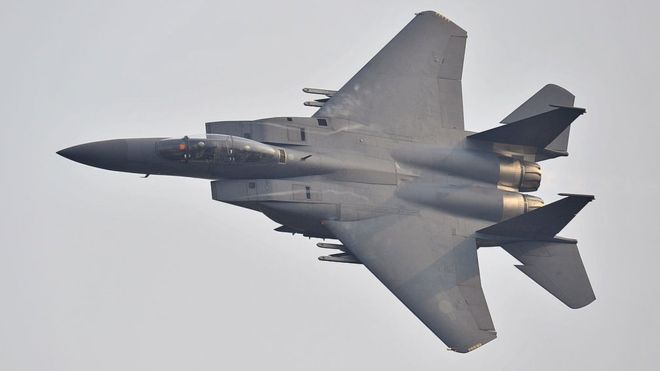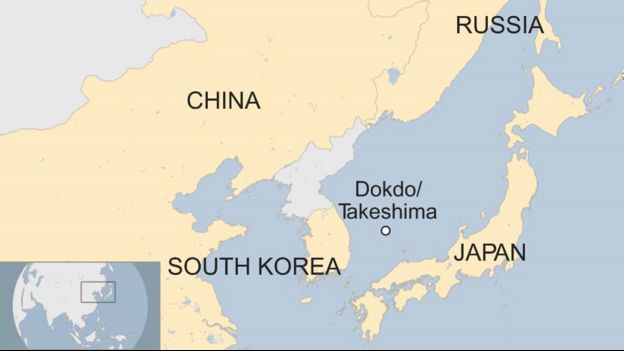
South Korea says its jets fired warning shots at a Russian surveillance plane that entered its airspace on Tuesday.
Officials said the plane twice violated the airspace over the Dokdo/Takeshima islands, which are occupied by Seoul but also claimed by Japan.
South Korea’s Ministry of Defence said it scrambled fighter jets in response and fired 360 machine-gun rounds.
Russia has denied violating the country’s airspace.
Moscow said two of its bombers carried out a planned drill over “neutral waters” and denied any warning shots were fired by South Korean jets.
This is the first incident of its kind between Russia and South Korea.
What does South Korea say happened?
South Korea’s military said that in total three Russian and two Chinese military aircraft that entered the Korea Air Defense Identification Zone (KADIZ) on Tuesday morning.
It said this group was made up of two Russian Tu-95 bombers, one Russian A-50 surveillance plane and two Chinese H-6 bombers.
Russian and Chinese bombers and reconnaissance planes have occasionally entered the zone in recent years.
Overseas aircraft must identify themselves before entering the KADIZ.

South Korea said one of the Russian planes – the A-50 – flew beyond the KADIZ and entered the country’s territorial airspace at around 09:00 local time (00:00 GMT).
South Korean F-15 and F-16 planes were deployed to intercept it.
The military said it fired 10 flares and 80 machine-gun rounds during the alleged first violation.
It said the Russian plane then left before circling back round again, when it was met by 10 more South Korean flares and 280 machine-gun rounds.
In its statement, Russia only mentioned two bomber planes. It did not specifically acknowledge the accusation that it had also sent an A-50 that had strayed.

Dokdo/Takeshima
- Known as Dokdo (Solitary islands) in Korea, Takeshima (Bamboo islands) in Japan
- Claimed by Japan and South Korea, but occupied by South Korea since 1954
- Just 230,000 sq m in size

What has the response been?
The head of South Korea’s National Security Office, Chung Eui-yong, has lodged a strong objection with the Security Council of Russia, and asked the council to take appropriate action.
“We take a very grave view of this situation and, if it is repeated, we will take even stronger action,” the South Korean president’s office quoted Mr Chung as saying.
The Japanese government has lodged a complaint against South Korea and Russia.
Chief Cabinet Secretary Yoshihide Suga said: “In light of Japan’s stance regarding sovereignty over Takeshima, the South Korean military aircraft’s having carried out warning shots is totally unacceptable and extremely regrettable.”
There has been no comment from China.

So was this a mistake? Did this Russian plane accidentally stray into South Korean territory?
Officials in South Korea said it was an A-50 aircraft, a type of warning and control plane that is capable of carrying out surveillance and tracking targets on the ground and in the air.
It encroached on South Korean territorial airspace not just once – but twice.
It is also worth noting that the Russian aircraft appeared to have been taking part in exercises with the Chinese. In recent years, Seoul has become increasingly concerned about China’s incursion in its airspace, including the use of spy planes, and has raised the issue with Beijing.
Last year, China’s People’s Liberation Army took part in Russia’s large-scale VOSTOK military exercises for the first time. It was a chance to show off their alliance and combined strength. They have done that again now, over the Korean peninsula – perhaps either testing or prodding a US ally, just as Donald Trump’s National Security Advisor John Bolton arrives in Seoul.
Flying over Dokdo is controversial. The island is occupied by South Korea but also claimed by Japan, which calls it Takeshima. The two sides are also currently locked in an escalating and bitter trade dispute.
This incident may demonstrate just how isolated South Korea could be in the region – but also that Seoul will take action to defend its territory when provoked.
